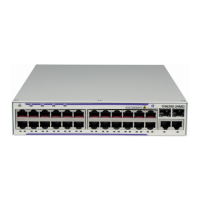MPLS and RSVP
7210 SAS M, T, X, R6, Mxp MPLS Configuration Guide Page 51
Note also that the static label ranges for LSPs, above, apply only to static LSPs configured using
the CLI tree for MPLS-TP specified in this section. Different scalability constraints apply to static
LSPs configured using the following CLI introduced in earlier SR OS releases:
config>router>mpls>static-lsp
config>router>mpls>interface>label-map
The scalability applying to labels configured using this CLI is enforced as follows:
• A maximum of 1000 static LSP names may be configured with a PUSH operation.
• A maximum of 1000 LSPs with a POP or SWAP operation may be configured.
These two limits are independent of one another, giving a combined limit of 1000 PUSH and 1000
POP/SAP operations configured on a node.
The static LSP and VC label spaces are contiguous. Therefore, the dimensioning of these label
spaces requires careful planning by an operator as increasing the static LSP label space impacts
the start of the static VC label space, which may already-deployed
Interface Configuration for MPLS-TP
It is possible for MPLS-TP paths to use both numbered IP numbered interfaces that use ARP/static
ARP, or IP unnumbered interfaces. MPLS-TP requires no changes to these interfaces. It is also
possible to use a new type of interface that does not require any IP addressing or next-hop
resolution.
Draft-ietf-mpls-tp-next-hop-addressing provides guidelines for the usage of various Layer 2 next-
hop resolution mechanisms with MPLS-TP. If protocols such as ARP are supported, then they
should be used. However, in the case where no dynamic next hop resolution protocol is used, it
should be possible to configure a unicast, multicast or broadcast next-hop MAC address. The
rationale is to minimize the amount of configuration required for upstream nodes when
downstream interfaces are changes. A default multicast MAC address for use by MPLS-TP point-
to-point LSPs has been assigned by IANA (Value: 01-00-5e-90-00-00). This value is configurable
on the 7210 to support interoperability with 3rd party implementations that do not default to this
value, and this no default value is implemented on the 7210.
In order to support these requirements, a new interface type, known as an unnumbered MPLS-TP
interface is introduced. This is an unnumbered interface that allows a broadcast or multicast
destination MAC address to be configured. An unnumbered MPLS-TP interface is configured
using the unnumbered-mpls-tp keyword, as follows:
config
router
interface <if-name> [unnumbered-mpls-tp]
port <port-id>[:encap-val]

